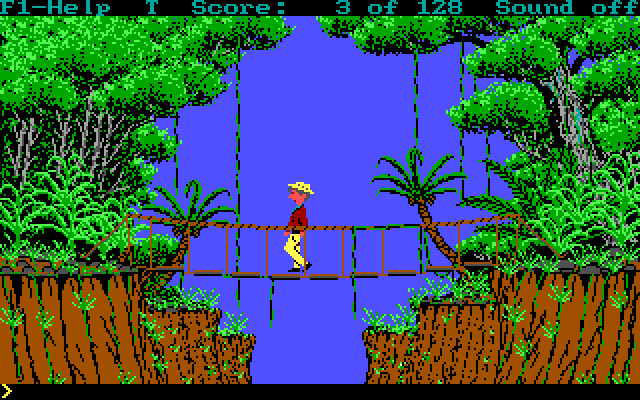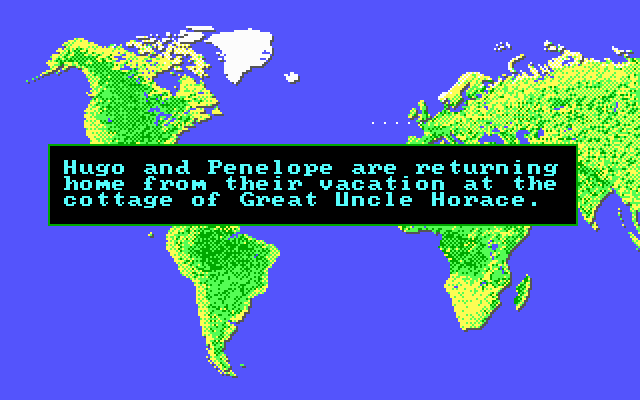Retro Replay Review
Gameplay
The core gameplay of Hugo III: Jungle of Doom sticks closely to the tried-and-true mechanics of its EGA adventure predecessors, yet adds subtle refinements that give it a fresh feel. Players guide Hugo through lush pixel-art environments, solving inventory-based puzzles and interacting with a cast of colorful characters. The familiar point-and-click interface remains intuitive, though the addition of a turbo button injects a welcome rush when exploring larger areas or backtracking.
(HEY YOU!! We hope you enjoy! We try not to run ads. So basically, this is a very expensive hobby running this site. Please consider joining us for updates, forums, and more. Network w/ us to make some cash or friends while retro gaming, and you can win some free retro games for posting. Okay, carry on 👍)
One of the most notable new features is the built-in hints system. Rather than resorting to external walkthroughs, casual adventurers can now access tiered clues that nudge them toward solutions without outright spoiling key puzzle mechanics. This hint feature helps balance the line between challenge and frustration, making Hugo III more approachable for players who found earlier EGA adventures overly cryptic.
Puzzle design in Jungle of Doom continues the series’ tradition of clever logic conundrums, though it leans slightly more on environmental interaction than on purely inventory-based riddles. From discovering secret pathways behind vines to mixing jungle herbs for antidotes, the game encourages exploration. The pacing is generally smooth, with only a handful of puzzles that require trial-and-error experimentation.
Combat remains minimal, focusing instead on avoiding traps or outwitting hostile jungle creatures. Encounters with the witch doctor and his minions are resolved through creative puzzle solutions rather than action sequences. For fans of pure adventure gameplay, this emphasis on brain over brawn is a welcome choice, preserving Hugo’s old-school charm.
Graphics
Visually, Hugo III embraces the EGA aesthetic with a rich, eight-color palette that brings the South American jungle to life. The backgrounds are detailed, with dense foliage, tumbling waterfalls, and hidden ruins that reward close inspection. Sprite animations are smooth, especially Hugo’s walking and interaction gestures, which add personality to even the simplest actions.
Compared to its predecessors, the game adds more atmospheric lighting effects—dappled sunlight filters through treetops, and torchlight flickers in underground caverns. These enhancements deepen immersion and help distinguish Jungle of Doom from earlier, flatter EGA titles. Color contrast is used effectively to highlight interactive objects and pathways amidst the dark greenery.
Character designs are expressive without being overly complex. Penelope’s expressions as she weakens from the snake bite convey urgency, and the witch doctor’s twisted mask and animated dance sequences capture the sinister tone of the game’s antagonists. NPCs like local tribespeople and river boat captains are rendered simply but memorably, supporting a cohesive visual narrative.
While the EGA format naturally limits resolution and color depth by modern standards, Hugo III’s art direction turns these constraints into strengths. The game looks like a lovingly crafted storybook, where every screen invites a second look. For retro enthusiasts, the graphics offer a compelling blend of nostalgia and artistic care.
Story
Hugo III: Jungle of Doom opens with a dramatic plane crash that strands our heroes deep in an uncharted wilderness. From the moment Hugo and Penelope emerge among the vines, the narrative thrust is immediate: find a way to heal Penelope’s venomous wound before it’s too late. This ticking clock injects urgency into every puzzle and exploration segment.
The plot thickens as Hugo uncovers rumors of an ancient “pool of life,” said to possess miraculous healing powers. Along the way, he confronts a cunning witch doctor determined to keep the jungle’s secrets for himself. Story beats unfold through simple but effective dialogue windows, occasional cutscenes, and atmospheric set-pieces that underscore the witch doctor’s growing threat.
Character interactions are witty and occasionally self-aware, offering lighthearted banter even amid high stakes. Hugo’s determination shines through in every quip, while Penelope’s vulnerability keeps the emotional core strong. Side characters, such as helpful natives or mischievous critters, add texture to the journey without derailing the main narrative.
Though the overall storyline is classic adventure fare—stranded heroes, mystical cures, dark magic—the execution feels polished. Tension builds steadily, culminating in a final confrontation that tests both your puzzle-solving skills and your narrative investment. The ending wraps up Hugo’s saga neatly, making it a satisfying finale to the original EGA trilogy.
Overall Experience
Hugo III: Jungle of Doom delivers a well-rounded adventure that honors the legacy of its predecessors while offering incremental improvements. The blend of challenging puzzles, engaging story, and lush EGA visuals makes for a memorable finale to the series. Fans of point-and-click classics will feel right at home, and newcomers will appreciate the accessible hint system that eases them into the mechanics.
Replay value is moderate. While the main story can be experienced in a single playthrough, uncovering all secret areas and experimenting with alternate puzzle approaches adds extra hours of enjoyment. The hints feature can be toggled on or off, allowing veteran players to preserve the original level of difficulty if they prefer a pure challenge.
Sound design follows the series template, with upbeat MIDI tracks and ambient jungle noises that set the mood. Although audio fidelity is constrained by EGA-era hardware, the soundtrack’s catchy rhythms and tribal percussion enhance immersion. Sound effects—rustling leaves, distant animal calls, and Penelope’s coughs—are sparingly used but effective in reinforcing the atmosphere.
Overall, Hugo III: Jungle of Doom stands as a strong conclusion to the EGA Hugo trilogy. Its combination of polished graphics, thoughtful gameplay enhancements, and an engaging narrative make it a must-play for aficionados of retro adventure games. Whether you’re revisiting old favorites or discovering Hugo for the first time, Jungle of Doom offers a rich, satisfying journey through a perilous but enchanting world.
 Retro Replay Retro Replay gaming reviews, news, emulation, geek stuff and more!
Retro Replay Retro Replay gaming reviews, news, emulation, geek stuff and more!









Reviews
There are no reviews yet.